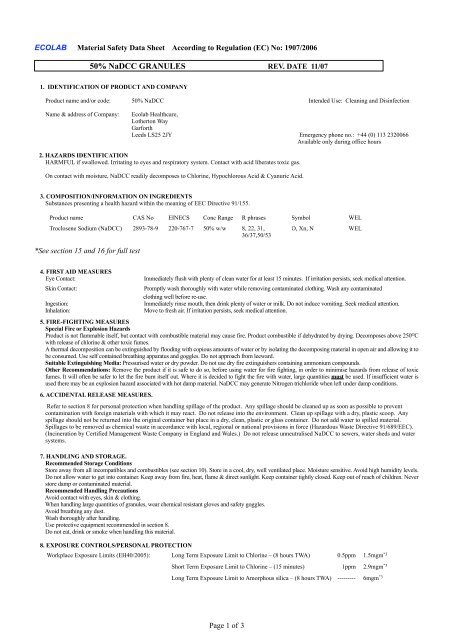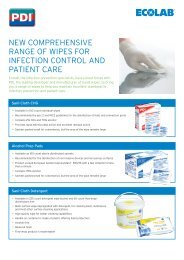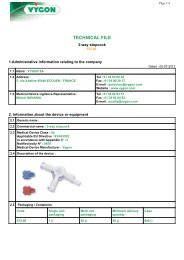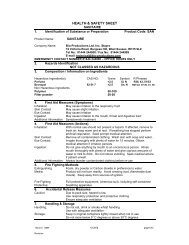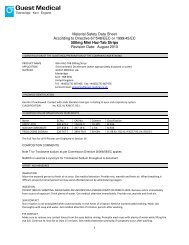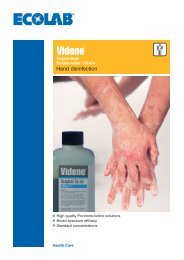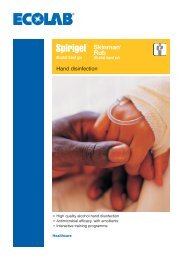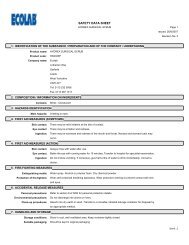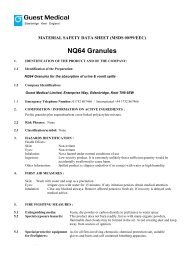Actichlor Granules - Medguard Healthcare
Actichlor Granules - Medguard Healthcare
Actichlor Granules - Medguard Healthcare
Create successful ePaper yourself
Turn your PDF publications into a flip-book with our unique Google optimized e-Paper software.
ECOLAB Material Safety Data Sheet According to Regulation (EC) No: 1907/2006<br />
50% NaDCC GRANULES REV. DATE 11/07<br />
1. IDENTIFICATION OF PRODUCT AND COMPANY<br />
Product name and/or code: 50% NaDCC Intended Use: Cleaning and Disinfection<br />
Name & address of Company:<br />
Ecolab <strong>Healthcare</strong>,<br />
Lotherton Way<br />
Garforth<br />
Leeds LS25 2JY Emergency phone no.: +44 (0) 113 2320066<br />
Available only during office hours<br />
2. HAZARDS IDENTIFICATION<br />
HARMFUL if swallowed. Irritating to eyes and respiratory system. Contact with acid liberates toxic gas.<br />
On contact with moisture, NaDCC readily decomposes to Chlorine, Hypochlorous Acid & Cyanuric Acid.<br />
3. COMPOSITION/INFORMATION ON INGREDIENTS<br />
Substances presenting a health hazard within the meaning of EEC Directive 91/155.<br />
Product name CAS No EINECS Conc Range R phrases Symbol WEL<br />
Troclosene Sodium (NaDCC) 2893-78-9 220-767-7 50% w/w 8, 22, 31,<br />
36/37,50/53<br />
*See section 15 and 16 for full test<br />
O, Xn, N WEL<br />
4. FIRST AID MEASURES<br />
Eye Contact:<br />
Skin Contact:<br />
Ingestion:<br />
Inhalation:<br />
Immediately flush with plenty of clean water for at least 15 minutes. If irritation persists, seek medical attention.<br />
Promptly wash thoroughly with water while removing contaminated clothing. Wash any contaminated<br />
clothing well before re-use.<br />
Immediately rinse mouth, then drink plenty of water or milk. Do not induce vomiting. Seek medical attention.<br />
Move to fresh air. If irritation persists, seek medical attention.<br />
5. FIRE-FIGHTING MEASURES<br />
Special Fire or Explosion Hazards<br />
Product is not flammable itself, but contact with combustible material may cause fire. Product combustible if dehydrated by drying. Decomposes above 250 O C<br />
with release of chlorine & other toxic fumes.<br />
A thermal decomposition can be extinguished by flooding with copious amounts of water or by isolating the decomposing material in open air and allowing it to<br />
be consumed. Use self contained breathing apparatus and goggles. Do not approach from leeward.<br />
Suitable Extinguishing Media: Pressurised water or dry powder. Do not use dry fire extinguishers containing ammonium compounds.<br />
Other Recommendations: Remove the product if it is safe to do so, before using water for fire fighting, in order to minimise hazards from release of toxic<br />
fumes. It will often be safer to let the fire burn itself out. Where it is decided to fight the fire with water, large quantities must be used. If insufficient water is<br />
used there may be an explosion hazard associated with hot damp material. NaDCC may generate Nitrogen trichloride when left under damp conditions.<br />
6. ACCIDENTAL RELEASE MEASURES.<br />
Refer to section 8 for personal protection when handling spillage of the product. Any spillage should be cleaned up as soon as possible to prevent<br />
contamination with foreign materials with which it may react. Do not release into the environment. Clean up spillage with a dry, plastic scoop. Any<br />
spillage should not be returned into the original container but place in a dry, clean, plastic or glass container. Do not add water to spilled material.<br />
Spillages to be removed as chemical waste in accordance with local, regional or national provisions in force (Hazardous Waste Directive 91/689/EEC).<br />
(Incineration by Certified Management Waste Company in England and Wales.) Do not release unneutralised NaDCC to sewers, water sheds and water<br />
systems.<br />
7. HANDLING AND STORAGE.<br />
Recommended Storage Conditions<br />
Store away from all incompatibles and combustibles (see section 10). Store in a cool, dry, well ventilated place. Moisture sensitive. Avoid high humidity levels.<br />
Do not allow water to get into container. Keep away from fire, heat, flame & direct sunlight. Keep container tightly closed. Keep out of reach of children. Never<br />
store damp or contaminated material.<br />
Recommended Handling Precautions<br />
Avoid contact with eyes, skin & clothing.<br />
When handling large quantities of granules, wear chemical resistant gloves and safety goggles.<br />
Avoid breathing any dust.<br />
Wash thoroughly after handling.<br />
Use protective equipment recommended in section 8.<br />
Do not eat, drink or smoke when handling this material.<br />
8. EXPOSURE CONTROLS/PERSONAL PROTECTION<br />
Workplace Exposure Limits (EH40/2005): Long Term Exposure Limit to Chlorine – (8 hours TWA) 0.5ppm 1.5mgm - 3<br />
Short Term Exposure Limit to Chlorine – (15 minutes) 1ppm 2.9mgm - 3<br />
Long Term Exposure Limit to Amorphous silica – (8 hours TWA) --------- 6mgm - 3<br />
Page 1 of 3
50% NaDCC GRANULES REV. DATE 11/07<br />
ECOLAB Material Safety Data Sheet According to Regulation (EC) No: 1907/2006<br />
Respiratory Protection:<br />
Ventilation:<br />
Eye Protection:<br />
Skin Protection:<br />
Where any dust in the breathing zone cannot be controlled with ventilation, wear an officially approved<br />
respirator (NIOSH/MSHA or equivalent agency) for protection against airborne dust.<br />
Use local exhaust ventilation where appropriate<br />
If airborne dust concentrations are high, wear appropriate protective goggles. Wash eyes with clean water<br />
where there is potential eye contact.<br />
When handling large bulk quantities wear protective gloves.<br />
Wash immediately if skin is contaminated. Remove and wash contaminated clothing and clean up<br />
equipment before re-use.<br />
Wash thoroughly with soap and water after handling<br />
9. PHYSICAL AND CHEMICAL PROPERTIES<br />
Appearance: White flat bevelled tablet Vapour pressure: N/A<br />
Odour: Characteristic Chlorine Odour Relative density: N/A<br />
pH: As is - not applicable Partition coefficient: n-octanol/water: N/A<br />
pH: In solution - 5.0 - 6.0 approx. Viscosity: N/A<br />
Solubility: Freely soluble Vapour density: N/A<br />
Oxidising Properties: Non oxidising Evaporation rate: N/A<br />
Flash Point:<br />
Not flashing<br />
Flammability:<br />
Not flammable<br />
Autoflammability:<br />
Not autoflammable<br />
Explosion Properties:<br />
Not explosive<br />
10. STABILITY AND REACTIVITY<br />
Conditions to Avoid<br />
Do not store on or near heat sources or naked flame. Avoid moisture. NaDCC decomposes at temperatures above 240 O C liberating toxic gases.<br />
Materials to Avoid<br />
Contact with water liberates chlorine and with nitrogen compounds may cause explosion. Avoid organic materials, oils, grease, sawdust, reducing agents,<br />
nitrogen containing compounds, calcium hypochlorite, other oxidizers, acids, alkalis, cationic and certain non-ionic surfactants.<br />
11. TOXICOLOGICAL INFORMATION<br />
Route of entry: Inhalation, skin contact & ingestion.<br />
Inhalation of NaDCC is irritating to the nose, mouth, throat and lungs.<br />
Ingestion of NaDCC can cause irritation and or/burns to the gastrointestinal tract.<br />
Skin & Eye Contact: with NaDCC can cause severe irritation and/or burns, characterized by redness, swelling and scab formation. May cause impairment of<br />
vision and corneal damage.<br />
Toxicological Data: NaDCC<br />
Acute toxicity<br />
Oral LD50 (rat) ca. 1825mg/kg<br />
Eye Irritation (rabbit) Severe irritant<br />
Rabbit dermal LD50 >20,000mg/kg<br />
Carcinogenicity<br />
This chemical is not considered to be carcinogenic by any reference source.<br />
12. ECOLOGICAL INFORMATION<br />
NaDCC is highly toxic to fish. Do not discharge into lakes, ponds, streams or public water unless in accordance with the permit of official regulations.<br />
13. DISPOSAL CONSIDERATIONS<br />
Disposal should be done in accordance with local, regional or national provisions in force (Hazardous Waste Directive 91/689/EEC).<br />
Certified Management Waste Company in England and Wales.)<br />
(Incineration by<br />
14. TRANSPORT INFORMATION<br />
Keep container strictly dry<br />
Keep away from FIRE, HEAT, FLAME & DIRECT SUNLIGHT.<br />
UN Number: 3077 ADR/RID: Class 9 (M7) miscellaneous dangerous substances and articles<br />
Packing Group: III ICAO/IATA: No dangerous goods according to IATA - DGR<br />
IMDG Code: Class 9<br />
Proper Shipping Name:<br />
15. REGULATORY INFORMATION<br />
Label for supply:<br />
HARMFUL<br />
ENVIRONMENTALLY HAZARDOUS SUBSTANCE, SOLID, N.O.S.<br />
(Sodium dichloroisocyanurate, anhydrous)<br />
Risk Phrases:<br />
R22 Harmful if swallowed<br />
DANGEROUS<br />
R31 Contact with acids liberates toxic gas<br />
R36/37 Irritating to eyes and respiratory system<br />
FOR THE<br />
R50/53 Very toxic to aquatic organism, may cause long term<br />
adverse effects in the aquatic environment.<br />
Safety Phrases: S8 Keep container dry<br />
S26 In case of contact with eyes, rinse immediately with plenty of water and seek medical advice<br />
S41 In case of fire and/or explosion do not breathe fumes<br />
Regulatory References:<br />
The Chemicals (Hazard Information & Packaging & supply) (Amendment) Regulations 2005 (Chip3.1)<br />
HARMFUL<br />
Page 2 of 3
16. OTHER INFORMATION<br />
Full test Risk phrases (section 1): 51/53 Very toxic to aquatic organisms, may cause long term adverse effects in the aquatic environment.<br />
The information herein is based on data considered to be accurate as of the date of preparation of the Material Safety Data Sheet. However, no warranty or<br />
representation, expressed or implied, is made as to the accuracy or completeness of the foregoing data and safety information. The user assumes all liability<br />
for any damage or injury resulting from abnormal use, from any failure to adhere to recommended practices or from any hazards inherent in the nature of the<br />
product.<br />
Page 3 of 3


